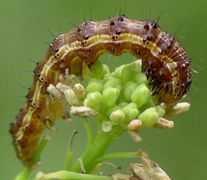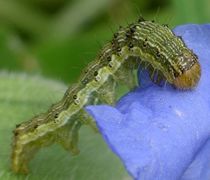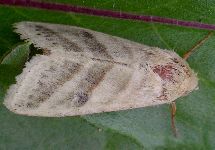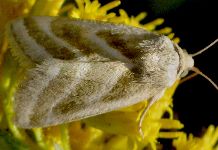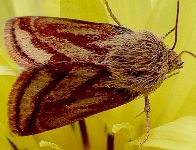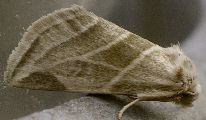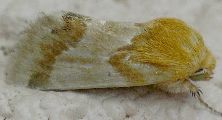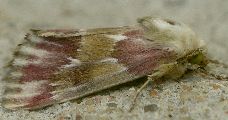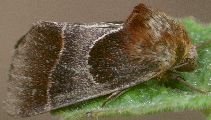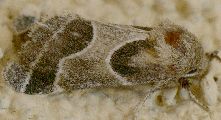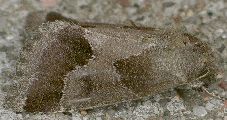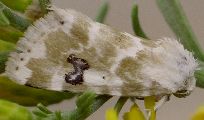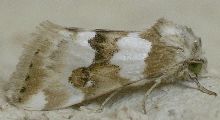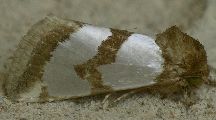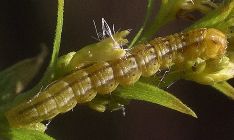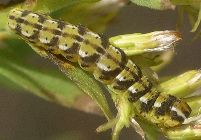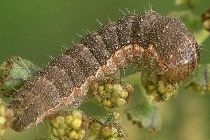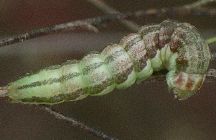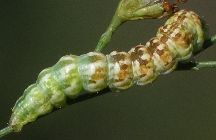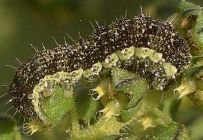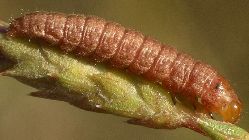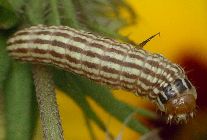
| Noctuidae ~ Owlet Moths |
page 1 ![]() page 2
page 2 ![]() page 3
page 3 ![]() page 4
page 4 ![]() page 5
page 5 ![]() page 6
page 6 ![]() page 7
page 7 ![]() page 8
page 8
|
One of the most numerous caterpillars found in flower gardens is the Tobacco Budworm (Heliothis virescens). I am not 100% sure of this ID, but I don't know what else would look so similar, and I have found the occasional adult. This identification may need revision in the future. Look at some of the pretty colors these caterpillars come in!
I've seen Plagiomimicus tepperi once so all I know about it is that it is a 12 mm long brown banded moth that seems uncommon and can be found in Sept. It looks rather similar to the Tobacco Budworm Moth (Heliothis virescens) but the latter is slightly bigger, at 15 mm in length. For how common the budworms (caterpillars) are, it is surprising that I rarely find adults. There is one more brown banded moth and it is one of the species in the large genus Schinia, the flower moths. Although the Three-lined Flower Moth (Schinia trifascia) is found in our area, I took this photo in Georgia and have not yet encountered it here. Most Schinia species are rather small, ranging from 11 to 15 mm in length. They are often very closely associated with their various host plants. All the following were photographed in Austin except for Schinia siren, which was found in Dallas. They are mostly found in the fall and only Schinia mitis was seen in April. While flower moths are attracted to lights like many other species, they can also be found around their host plants. In fact, I've only seen the Goldenrod Flower Moth (S. nundina) actually on the flowers of Goldenrod. By far the most numerous species I find is the Broomweed Flower Moth (Schinia chrysellus). I've seen the Arcigera Flower Moth (S. arcigera), Thoreau's Flower Moth (S. thoreaui), and the Ragweed Flower Moth (S. rivulosa) just a couple times each. The Bleeding Flower Moth (S. sanguinea) and S. alencis have been just single sightings.
Because of their host specificity, it is possible to find the cryptic caterpillars by examining the flowers and buds of their favored plants. The caterpillars are as small as might be expected from the adult size, and they average just around 20 mm, so you have to look close. They can also be rather variable in color and even pattern. Thoreau's Flower Moth caterpillars host on Giant Ragweed (Ambrosia trifida) which we have in abundance around here. They seem to appear when the plant is flowering and usually can be found munching the blossoms. However, about that time the leaves are also starting to die off and the charcoal color of the caterpillars matches the dead leaves perfectly!
The Goldenrod Flower Moth (S. nundina)larvae are rather common on large stands of Goldenrod (Solidago sp.), where they hide within the flower heads. S. chrysellus is fairly common every year and can be found on Broomweed (Xanthocephalum sp.). Even though the caterpillars are much fatter than the stems on which they rest, their cryptic coloration still makes it difficult to spot them.
These last two species are unknown to me. The striped one was feeding on Gaillardia and the orange one on Liatris. |
page 1 ![]() page 2
page 2 ![]() page 3
page 3 ![]() page 4
page 4 ![]() page 5
page 5 ![]() page 6
page 6 ![]() page 7
page 7 ![]() page 8
page 8
![]()
